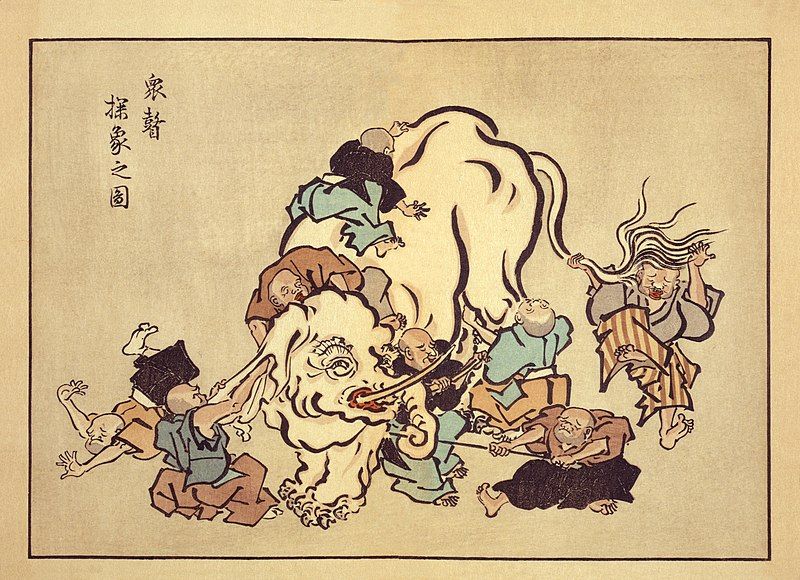-----------------------------------------------
Blind Men & Elephant parable
The parable of the blind men and the elephant is used to illustrate how biases can blind us, preventing us from seeking a more complete understanding on the nature of things. It is often used as a warning against the promotion of absolute truths.
The story of the blind men and an elephant originated in India (Pali Buddhist Udana) from where it is widely diffused. Made famous by the great Sufi master Jalal ud-din-i Rumi (1207-1273 c.e.) in his
Mathnawi of Jalalu’ ddin Rumi, the parable has been used to illustrate a range of truths and fallacies.
“Blind monks examining an elephant” by Itcho Hanabusa 1888
The parable went something like this:
In a distant village, a long time ago, there lived six blind men. One day the villagers announced, “Hey, there is an elephant in the village today.”
They had never seen or felt an elephant before and so decided, “Even though we would not be able to see it, let us go and feel it anyway.” And thus they went down to the village to touch and feel the elephant to learn what animal this was and they described it as follows:
“Hey, the elephant is a pillar,” said the first man who touched his leg.
“Oh, no! it is like a rope,” argued the second after touching the tail.
“Oh, no! it is like a thick branch of a tree,” the third man spouted after touching the trunk.
“It is like a big hand fan” said the fourth man feeling the ear.
“It is like a huge wall,” sounded the fifth man who groped the belly .
“It is like a solid pipe,” Said the sixth man with the tuskin his hand.
They all fell into heated argument as to who was right in describing the big beast, all sticking to their own perception. A wise sage happened to hear the argument, stopped and asked them “What is the matter?” They said, “We cannot agree to what the elephant is like.”
The wise man then calmly said, “Each one of you is correct; and each one of you is wrong. Because each one of you had only touched a part of the elephant’s body. Thus you only have a partial view of the animal. If you put your partial views together, you will get an idea of what an elephant looks like.”
At various times it has provided insight into the relativity, opaqueness or inexpressible nature of truth, the behaviour of experts in fields where there is a defecit or inaccessibility of information, the need for communication, and respect for different perspectives.
Although the parable’s function is to call attention to a lack of objectivity and consideration of other approaches and perspectives when trying to understand the nature of things, we do have to warn that not all perspectives are equally valid, and even valid arguments are not necessarily equally sound. I would like to thank Dr. Peter Kabai for this reminder.
Each of us lives in our own world, with our own life experiences and sensory perceptions, which often lead us to biases characterized by a lack of general objectivity, open-mindedness or the consideration of the points of view of others.
In a world where issues are usually and uncritically two sided: black or white: good or bad; ethical or unethical, it is easy to fall into heated debates, each defending a point of view often times equated to truths.

